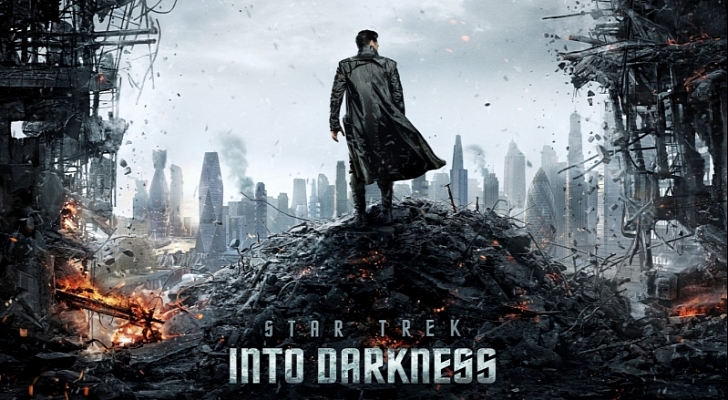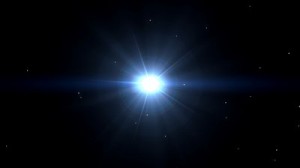Before we get into anything else, I need to bring something to your attention:
If the large star towards the centre of this image is your brain
Then this is your brain directed by JJ Abrams
The man is obsessed with lens flair to the point where it becomes really distracting. He seems to find light sources to flair where there are no light sources. He could find something to flair in a coal mine at night.
Right. Star Trek Into Darkness. I am not a Star Trek fan, in general. Before this entry I’d seen, maybe, three of the films in the series. I think I’ve seen one of the original films though I couldn’t tell you which. I’m fairly certain I saw the first of the Next Generation films. And I saw JJ Abram’s 2009 re-imagining/reboot, which was a film which made little sense but which had a perky spirit which made you shrug your shoulders and go along for the ride. It wasn’t great though.
The story here makes almost as little sense as the previous installment. Benedict Cumberbatch attacks Star Fleet for some reason (later explained by a combination of Star Trek folklore and shoulder-shrugging-go-with-it-nonsense), Kirk and co are sent after him, and everyone seems to have an ulterior motive that doesn’t make much sense at the time but makes even less sense later. Then stuff explodes, other stuff gets destroyed, and the earth’s gravity strengthens to the point at which surely it would be pulling the moon into a collision course.
I was under the impression that Star Trek was deep. Or was supposed to have depths, at any rate. It was about humanity, about learning from humanities mistakes, about providing a guiding hand, a gentle nudge, to other civilisations without revealing themselves. It was sociology and psychology with a bit of space thrown in, and occasionally the opportunity to stun (but not kill) a Klingon.
This is not the Star Trek that JJ Abrams is interested in. The Prime Directive (a big deal, I’m told) is ignored in the first 10 minutes in favour of a massive special effects sequence, and from then on things such as nuance, character and story are also eschewed for special effects. This isn’t necessarily a bad thing. Fast Five, the fifth Fast & Furious movie, was brilliantly entertaining while also containing no sense of character, story, nuance or acting nous (and Star Trek definitely contains people who can act). Actually, it’s unfair to say that there’s no character in Star Trek. There are a number of clearly defined characters, but there’s little in the way of growth or change come the end.
The problem is that the story is at the remedial end of the spectrum and seems like a betrayal of what I had been led to believe Star Trek stood for. What is left is a bright, shiny action movie that, while well shot, still offers little that differs from other action movies. This one is set in space and has Simon Pegg doing a silly accent and it takes itself a little less seriously than some, but otherwise this could just as easily be a Battleship, or some other dumb action film from the past few years.
The other problem that I had, though I know others disagree, is that the Pegg sequences felt like they came from a different movie. There’s a fair amount of earnestness on view around and about the place, but Pegg’s scenes feel like they come from an alternate reality to the rest of the film.
Actually, I had more problems than that – they’re going to keep coming. It looks beautiful. The alien world with the red plants in the basically unrelated opening sequence looks incredible. It’s a pretty original visual concoction. But it’s not real. And this is something that makes the film really suffer. Aside from the bridge of the Enterprise, I’d be hard pushed to identify anything that was a genuine set, as opposed to being predominantly CGI’d within an inch of existence. It’s hard to care about stuff when you’re aware that most of that stuff doesn’t actually exist.
And no, that doesn’t mean I can’t care about anything animated – in an animated film, everything is animated and thus characters and locations are all part of one and the same existence, whereas here the actors don’t exist in the same time/place as their surroundings. When you get that distance it leads to an emotional detachment. So where that opening sequence with the red plants looks glorious, all of those plants look fake, generated, animated, and thus not part of the world of the characters.
The human eye is very good at detecting fakery and the closer something is to looking real while not quite being real, the more unnerving it is. It’s called the uncanny valley. But that’s something for another time.
In the meantime, Star Trek Into Darkness is a fairly fun CGI rollercoaster, but one that has abandoned its principals and become one of the crowd, rather than something that stands out from the crowd. It will, undoubtedly, inspire love in many people, but it will leave others cold. I was one of them.
C
SPOILERS
So, I have a couple of others things to raise, but they would spoil the film. If you read this, it’s your own fault, because I put the word spoiler up there. See? SPOILERS. And there too.
So. Galaxy Quest was a brilliant parody of Star Trek dating back to 1999. Genuinely funny and heart-warming as well as providing a good sci-fi adventure. In that they identified the red-shirt-trope, wherein on any mission in original Star Trek Kirk et al would beam down with an anonymous crew member in a red shirt. You knew red-shirt would die. As I said, I didn’t watch Star Trek so I don’t know if these crew members were mourned in any way or if everyone shrugged them off as expected collateral damage, However, there’s an awful lot of collateral damage in this film that no one seems to care about.
First of all the Enterprise is bombarded and huge sections appear to be destroyed with plenty of crew being sucked out into space or torn limb from limb by the explosions. Space/submarine films will often have a scene where someone makes the agonising decision to close an airlock and kill some healthy people in order to save the larger crew. These scenes bring a human element to the spectacular nature of the explosions. In Star Trek Into Darkness no such considerations are made. The damage wrought is there as eye candy and the human cost doesn’t come into it.
Right at the end of the film a massive space ship crashing into a city on Earth causing damage far in excess of anything like 9/11 – one shot used is given an ‘amateur’ feel which makes it uncomfortably like the firefighter footage of the planes hitting the buildings in New York. This incomparable human drama, the massive loss of life, is touchingly referenced in two lines of dialogue in a speech given a year later.
Now, I get that, in this second example, they couldn’t exactly suddenly turn the film into a drama about a family who lost their patriarch (or matriarch) in this tragedy, and how it tore them about emotionally and their lives were never the same, but equally films pull this trick so frequently where massive damage has little consequence and is only paid lip-service briefly at the end that I have really come to resent it, especially in a film series like Star Trek where ‘humanity’ is supposed to be a key part of the equation.
I guess that’s all part and parcel of being a modern action franchise, but it’s a shame it’s losing touch with its roots (roots I admit to not being in touch with myself).
Also, in this film, they seem to manage to create a serum that can bring people back from the dead, thus removing any future sense of risk surrounding any future events.


